High Powered History: The Adventures of Mossman, Daven, and Weston
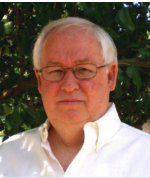
[August 2012] Do you remember the first time you saw an actual radio studio? For many of us, it was a life-altering event. Bob Mayben tells us about his, and how it led to a life-long hobby.
What got me interested in broadcasting? It was the equipment.
I was eleven when my dad took me with him to an office building. He did business and I found my future. Through the classic double glass window in the main hall, I saw my first radio station. And as soon as I was able, I began my lifelong love affair with radio, and as you will see, broadcast consoles.
Over the years, I have operated, bought, sold, repaired, or refurbished countless broadcast consoles. Having had the chance to play with so many consoles, I have found my favorites are all old classics: the Collins 212-E2, the RCA BC-6, and the Gates CC-1. But hold on a minute, we are getting ahead of ourselves.
Number One
That first station that opened my 11-year-old eyes wide was WCAS, 570 kc (yes, it was a few years ago), a Daytimer in my hometown of Gadsden, AL.
Through the window it looked like the sort of stuff you would see in an American-International sci-fi movie.
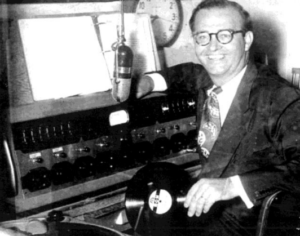
I now know there was a Gates SA-40 console, 2 CB-100 turntables, an RCA 77D on a Atlas “Baby” boom, a couple of Magnecord PT-6’s, and that beloved 12-inch acoustic tile on the walls.
All in all, it was pretty much the state-of-the-art for 1950’s radio!
Love at First Sight
As I said, from my fascination with the guy and what he was doing, my love for this business was ignited.
Back at home, I quickly got my record player, and occasionally my sister Gail’s player (after all, you gotta have two turntables!), and found a suitable candlestick table lamp that became my pretend microphone.
From that day on, two passions took me over: wanting to be a disc jockey and DX listening.
My trusty Sears & Roebuck Silvertone radio brought in stations all over the region – and I listened to all of them, writing down the call letters and location, and comparing my information with “White’s Radio Log,” available in Popular Electronics magazine.
Making a Career of It
Once I got my first wheels (a Cushman Eagle motor scooter) I began making the rounds of the stations to see if I could get a foot in the door. Gadsden (AL) only had three stations then, and only two had night time authorization.
WGAD was the closest to my home, so I knocked on the glass door at the front of the station and offered to get the man on duty something to eat, if he would let me watch him work.
It worked! For the price of a Bar-B-Q I had made it inside a station.
In the Control Room lived a Gates Dualux, a Western Electric 639B, 2 CB-100’s and three Ampex 600’s.
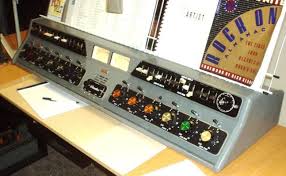
Life was good.
Hands On
This ploy also worked at WAAX, where in 1962 Mike Morelock was even agreeable to let me run the board, (a 1960 Gatesway, flanked by two CB-500’s with the Japanese copies of the Gray Research 16” arms, 2 trusty Ampex 601’s, and a Shure 55S microphone.
In the radio world in which I grew up, the console was the heart of the radio station control room. It was the “hands on” thing that drove the station. How well you drove it determined if you were “tight” – or not.
Aspiring broadcasters learned quickly that all boards are alike, and all boards are different.
Microphone to Transmitter
If you look at pictures of control rooms in the 1920’s and 1930’s, it is hard to tell what kind of “speech input” system is in use.
There certainly was a lot of equipment. The transmitter was a fairly large and often located near to or on the roof of the building. Consoles – at least as we think of them – did not come until later.
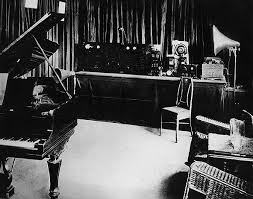
Note the two horn microphones
(Courtesy: John Schneider)
The 1922 studio at KPO, San Francisco Note the two horn microphones (Courtesy: John Schneider)
Performing on radio was quite an adventure! In those days, a single microphone often was right in the transmitter control room. Sometimes, the microphones were even at a high voltage potential. Performers were grouped around the microphone with physical distance to “set the levels.” A secondary microphone might be mounted by the piano, for example, and merely “selected” to go on the air – perhaps via a patch cord.
Before long, though, it was deemed important to build a studio for the performers, so sufficient space could be provided for the talent and the ambient sound could be better controlled.
KGO in 1924. The main microphone was in the middle of the room. Another was on the cabinet at the left. (Courtesy: John Schneider)
As the different network programs grew, from orchestral to drama and comedy, producers needed a way to add more sources to better capture the performers, sound effects, etc.
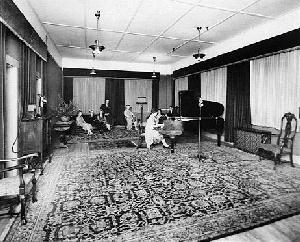
The main microphone was in the middle of the
room. Another was on the cabinet at the left.
(Courtesy: John Schneider)
Microphone to Mixer to Transmitter
Early on, audio control was fairly rudimentary: microphones were patched directly into transmitters.
However, as stations tried to use more sources, they needed a way to have more than one feeding the transmitter at a given time. And just as important, there needed to be a way to keep the audio levels relatively balanced. The solution was for stations to build their own custom audio mixing consoles, sometimes from spare parts, sometimes with a great deal of design thought.
This is where we meet Mossman, Daven, and Weston.
Mossman, Daven and Weston
Who – or whom (my senior year English teacher’s words still ring in my ears) – you might ask are Mossman, Daven and Weston? These are the companies that took us from twisted wires often carrying distorted audio to mixers that brought radio to a new plateau.
Mossman (along with Capitol) were by far the major suppliers of telephone type lever switches. They likely got that name because Ma Bell literally used thousands of them in her switchboards and associated devices.
These telephone type lever switches were very handy because of their ability to suit a variety of applications. The lever (sometimes called a key switch) could:
1. Connect a circuit to the mixing buss.
2. Remove the “load” into which the audio circuit looked.
3. Simultaneously activated 24 Volts of DC to mute the cue speaker and monitor amp output if necessary.
2 dB Per Step
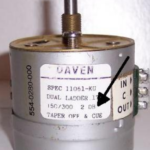
Almost every rotary attenuator in almost every console I have seen bares this legend.
And the Daven Co. of New Jersey hands down has supplied more of these 600/600, 150/300, etc., level setting pots than you can shake the proverbial stick at.
Someday we will discuss why Gates/Harris liked 150 Ohms in and 300 Ohms out, Collins liked 600 Ohms in and 1200 out – but almost everyone at some time has used the standard 600 Ohms in and out as their value of choice.
When Daven closed their doors, Shallco or Shallcross from the Carolinas came to the front with their continuation of this indispensable device. I have seen other makes including Aerovox, Cinema Engineering and Altec.
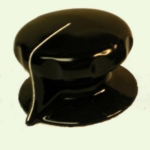
At this point I also have to mention my favorite knob: the 2 inch fluted with pointer item that was always seen on early RCA, GE, and Collins gear. In my humble opinion it is a thing of beauty within itself.
A Level Reference
That brings us to Weston – the meter guys.
After years of meters that showed just arbitrary levels and indications, the VU-meter was developed in 1939 by the combined effort of Bell Labs, CBS, and NBC for measuring and standardizing the levels of telephone lines. In 1942 it became the ANSI standard for consoles and mixing devices.
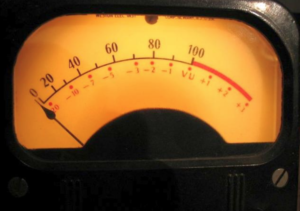
Weston, Simpson and Burlington made a pile of these instruments for us, and most consoles from the 50’s, 60’s and into the 70’s used one of these manufacturers products. Modutec came along and had great success as well. Gates-Harris and BE both used Modutec in their lines, especially in the 80’s.
Putting All the Parts Together
In time, stations looked to manufacturers who built audio consoles that used the well-known and trusted parts.
Perhaps one of the first manufacturers of commercial consoles, in the way we think of them, was from Western Electric.
In quick order, WE, RCA, General Electric, Western Electric, Collins, and Gates, along with others, began to produce consoles for stations, making it easy to “plug and play” audio.
A Lot to See
Once consoles were being mass produced, it made life a lot easier for stations. They could buy a product with built-in source, line, and output transformers and amplifiers.
How we got from the early “Speech Input Bays” as they were known to today’s digital consoles is a good story of adaptation and improvement.
We will return shortly and discuss how and why consoles changed to meet the needs of stations.
As they used to say: “Please Stand by.”
Until then, do not forget to fade down the microphone pot, you never know when the relay will stick or the contacts will not release and you will get in big trouble. Yes, I have been there, too!
– – –
Bob Mayben runs the mid-South office of SCMS, equipment suppliers to the broadcast industry for 36 years.
You can contact Bob to talk about consoles or to share your pictures with us at: bobmayben@usa.net or at 877-391-2650
– – –
Did you enjoy this article? If so, you are invited to sign up for the one-time-a-week.BDR Newsletter.
It takes only 30 seconds by clicking here.
– – –
